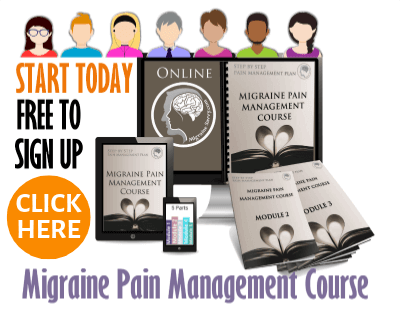- Home
- Meditation
- Mindfulness Meditation for Migraine
COMPLETE MAGNESIUM SUPPORT
My Top Choice - Magnesium Breakthrough - The ONLY supplement with all 7 essential magnesium types in one formula. Most only have 1-2 types, leaving you deficient.
Mindfulness Meditation For Migraine: How To Shorten Your Attacks
Numerous studies prove that using mindfulness meditation for migraine headaches can reduce migraine frequency and severity with regular practice. Techniques like
Vipassana, mindfulness, transcendental meditation and guided
visualizations all show benefits.
Below are some ideas to experiment with to find the right meditation to help ease your migraines.
When you practice mindfulness, you focus your attention on the task that you are doing and in this way your thoughts will be about the simple tasks you are doing rather than having other mental thoughts intrude.
Like that to do list.
The brain has a negativity bias, so you're more likely to hear negative comments like berating or criticizing yourself whilst performing a task.
Mindfulness is more a place of being with the doing rather than thinking about the doing.
If you think of Tai Chi or other martial arts or yoga or rock climbing, one’s concentration and energy is focused on the task at hand rather than thinking about other things.
So mindfulness is learning to be focused on just one thing at a time.
This is not to be confused with meditation where you sit down to go into an altered state of consciousness. Mindfulness is a way of being when you are not overpowered or controlled by your thoughts. And remember...
Your thoughts are not always right!
You will need to slow down if you are used of a fast paced life. So, you might find it easier to be mindful just before or after a migraine when you can slow right down naturally.
What To Focus On When You're In Pain
There are numerous methods, focusing on the breath is most common, but that might be hard with a migraine approaching, so let's start here...
Shinzen Young uses three methods: turning towards, turning away, and focusing on change. Focusing on change means to watch the flow and be aware of the flow and changes in your pain. I used to watch my migraines move all over my body, they would even go through my feet.
Have you experienced that?
Mr. Young talks about the turning away strategies as:
- Focus on relaxation – physical or mental.
- Focus on positive thoughts and emotions. He calls this the feel, image, and talk reactions.
The turn toward technique uses the focus on physical sensations like touch.
And the focus on change method directs your attention to follow and become aware of the flow through the body and the changes in the pain.
This can be easy... until the pain gets too intense.
Focus on any change in movement, flow, location, size, texture, color, intensity, emotional connection, etc.
One Practical Example For You To Watch
In this series of 3 videos Shinzen Young does a guided mindfulness meditation with a man named Rich and goes through his pain. I know this is not migraine pain, but it will give you some idea of where to start.
This is only part 1 of his 3 guided mindfulness meditation example (this method can be easily adapted to suit mindfulness meditation for migraines):
A Guided Mindfulness Meditation for Migraine Pain Relief
1. Find a comfortable sitting position either on the floor in lotus
position or in a more comfortable chair. Make sure your spine is
straight.
2. Take a few deep full breaths – allow the breath to fill the lungs. Slowly and gently exhale. Allow your breath to find its natural rhythm. Bring your attention to the strongest sensations of your breath moving.
Notice the rise and fall of your abdomen with each
inhalation and exhalation. There is no right or wrong way to breathe. Notice the cool movement of air right at your nostrils.
3. This is the hard part. Once you feel that your body is more relaxed and your mind is calmer “embrace and penetrate" the pain! Observe how the pain in the head shifts, morphs, expands, contracts, spreads and pulsates.
Note and mentally label the sensations as "flow". I would even suggest to say that quietly to yourself. Flow ..... flow...
4. Remain as a
neutral observer watching your pain move around your body. It is
important to remember that while doing your guided mindfulness
meditation you are to maintain a passive attitude.
5. The pain should peak and then eventually dissipate. Your awareness may shift, “instead of observing the pain, you begin to feel its wave-like sensations. When you notice the wavy sensation, just ride it. A few moments later, you’ll notice that the pain just vanishes. It is replaced by a relaxed and open attention. Continue with the meditation session as usual.” (1)
This is how it worked for one
meditator; however I did not have this experience. I could watch the
pain move all over my body, for days (10 in most cases) and follow the
flow and wave he describes, but the pain only intensified. I just passed out from the pain
eventually.
Please read about the 4 phases of migraine, so you won't encounter this problem.
Be gentle with yourself if you try this method. If the pain does not dissipate you may want to find another method.
The Body Scan Vipassana Style
Find a sitting position that allows you to be alert and relaxed at the same time. Rest your hands in your lap and allow your awareness to travel through your body. Up and down, scanning, and where it stops, soften, relax and let go in those tense areas.
The physical sensations will attract your attention, but don’t focus too long in one area.
Soften the hands, let go in the shoulders, and relax the abdomen.
You can easily get lost in thoughts, so the Vipassana technique often starts with awareness of the breath which helps quiet your mind. As you practice you might find a more useful anchor to use like your migraine pain, sounds, physical sensations or feelings that arise.
This teaching says "what’s important is that your sensations are awake" so you know you are here.
As far as I am concerned, what is important for you as a migraine sufferer is to learn what degree of intense pain you can sit with and remain an objective observer before the unbearable migraine pain phase starts.
Many theories say not to label it as pain, but to choose physical sensations instead.
 Use mindfulness meditation for migraine to soften the blow @migrainesavvy
Use mindfulness meditation for migraine to soften the blow @migrainesavvy
I used to do 10 day silent retreats in Vipassana meditation. They
were intense, yet so wonderful. In fact, I still recall some of the
extreme moments that occurred for me back then. It’s a very powerful
technique.
The practice I did scanned the body. The physical sensations become more and more intense. But it sure taught me that thoughts, feelings, and physical sensations come and go - "impermanence." I still remember watching a few sneezes come and go without actually sneezing.
I did this practice for many years watching my migraines. I find it much more intense than just doing a gentle guided imagery meditation which calms down the nervous system, inviting the sleep state.
I would not recommend such an intense form of meditation with a migraine coming on, a gentle mindfulness meditation for migraine would be best to take you away from the pain instead of into it.
But, hey don't let me stop you. Remember to experiment and find what works best for you. Finding the right mindfulness meditation for migraine, your unique migraines, is part of the journey.
The First Thing To Do...
The first thing I do when I feel a migraine approaching is grab my abortive medications and ice packs and go straight to bed. In a dark room.
Then I put on my MP3 player and listen to a guided mindfulness meditation for migraine. I suggest you find one that helps you drift off to sleep. Sleep is a great migraine aid.
Learning to meditate means you can go anywhere in your mind or just rest your (busy, worried) mind and go into your body. It’s so easy to learn and you can do it almost anywhere any time to bring inner peace and calm.
Plus you can use it over and over... and over. Pick one to learn and let yourself drift away from the pain.
I feel that a gentle mindfulness meditation for migraine that helps you drift off to sleep or away from the pain works best.
 Imagine feeling happy. See yourself in vibrant good health, pre-migraine, smiling or laughing.
Imagine feeling happy. See yourself in vibrant good health, pre-migraine, smiling or laughing.Your Guided Mindfulness Meditation for Migraine Using Imagery
Let me give you a quick example of a guided mindfulness meditation for migraine relief I do with clients.
Most meditation practices say not to label anything, so if I slip here and there, and use labels, please use the words that feel right for you.
1.
Bring your awareness to your breath. Feel the inhale and the exhale
and feel the coolness of the inhale. Allow your lungs, belly and chest
to fill with air. Allow the muscles to relax when you exhale.
Most guided
mindfulness meditations are about bringing attention to and being with
your breath. Take three conscious breaths with your awareness in your
body like this. Then follow the inhale inside your body. Let your
attention rest in your stomach or lower abdomen.
2. Now notice the weight of
your body sitting on the chair. Feel the chair supporting you and allow
yourself to settle into your sitting bones. Allow yourself to feel
held by that chair. Feel the touch of your feet on the ground. See if
you can feel mother earth or the ground supporting you, taking all your
weight - just supporting you.
3. Notice what you can hear outside the room, spend some time there (say two or three breaths) and then notice what you can hear in the room, and then inside yourself.
How was that for you? It didn’t take long did it? Do you feel a little more relaxed now? Add these if you have time...
4. Notice your body from the feet up. Wiggle your toes, feel your ankles, knees and thighs. Bring your attention back to your sitting bones on the chair, feel your chest, and neck.
Roll your shoulders, feel your
hands and fingers and allow your awareness to linger on your head and
face. Relax your eyes, nose and mouth. Relax those ears. Relax all
the places your migraines strike.
5. This is where we can adapt the guided mindfulness meditation for migraine. Hold an image in your mind's eye that makes you feel happy. See yourself in health, pre-migraine, smiling or laughing. I know that can be hard if the pain has already started.
For years I visualized a very small image of me
sitting at the back of my head putting out the sparks flying off the
nerve endings in my head. Peacefully and lovingly putting them out with
my hands as I meditated. I saw a smile on my face as I imagined the
migraine disappearing.
6. I would also visualize my healthy, clean blood flowing effortlessly in and out of my strong blood vessels all though my body, head and ended in my ears. Include the sides of your head around your ears, the side your migraine pain comes on most often.
Taking the time to meditate regularly helps reduce stress which is associated with migraine attacks.
Other Ways To Reprogram Your Brain Around Pain
When you experience chronic migraine pain, your mind develops a pattern of relationship with the pain.
You don’t want the pain. You want to ignore it, dismiss it, shut it out. You want it to go away. You might even fight with your body for having the pain.
Any mindfulness meditation for migraine can be very difficult to practice on your own when you are experiencing the intense pain from a migraine. It's often hard to think straight, so I've done a whole course with guided and mindfulness meditations, energetic healings and hypnosis for you to use and reuse. Over and over.
Here's the link - Meditations and Energetic Healing for Migraine Sufferers: Heal from the Inside Out.
Focusing therapy considers the mind's reaction to the pain. It acknowledges all that is there (emotional, physical). Unpleasant sensations, fear, worry, anger… whatever emotion is coming with the pain. Then turning towards that part of you and saying hello with compassion.
It's a great way to talk with your body and create some space, getting the right distance, between your mind that is aware of the pain and your body that is experiencing the pain. It makes it easier to truly observe objectively and with curiosity, change your relationship with the pain.
Using guided mindfulness meditation for migraine relief can redefine the relationship your mind has developed with your pain.
Until next time, be well.
P.S. You can also record the scripts on this page for yourself.
***Try adding these things to your visualizing: balanced blood vessels, relaxed eyes
muscles, balanced hormones, perfectly balanced neurotransmitters and a
balanced nervous system.***
More ways I can help right now...
WANT MORE TIPS? Subscribe to my newsletter and follow along on Facebook and Pinterest for all of the latest updates.
MIGRAINE MEDITATIONS Related Articles
How to be more MIGRAINE SAVVY right now...
Mindfulness Meditation for Migraine References:
1. C4Chaos (2012) Open Practice: How Vipassana Meditation
Relieves My Migraine Headaches. [Online], Available at: http://www.c4chaos.com/2009/07/open-practice-how-vipassana-meditation-relieves-my-migraine-headaches/
Accessed Sept. 30, 2017.
2. Study on Meditation for Severe Headache (2001) Department of Psychiatry, Department of Family Medicine, Chang Gung Memorial Hospital, Kaohsiung.



















